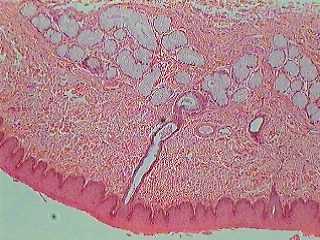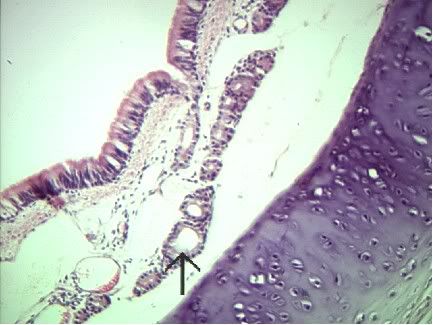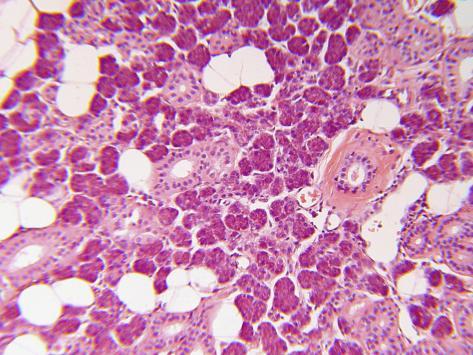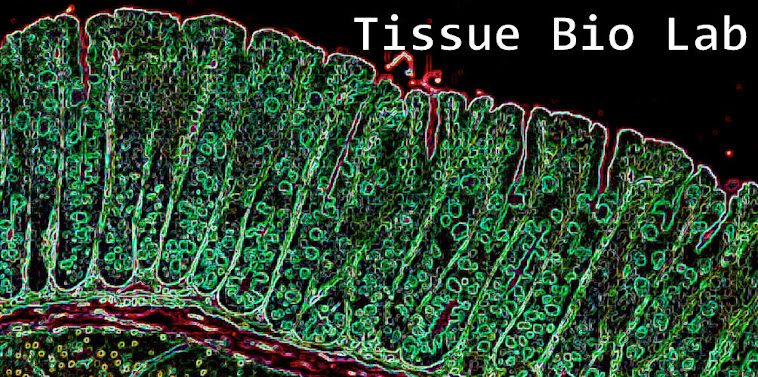Key points from this week:
For the exocrine portion of the lecture, make SURE you know each gland anatomically and histologically, as well as what organ it pertains to (e.g. Brunner's gland (anatomical name) is CMBT and is part of the duodenum (small intestine)). Also, be sure to study what each gland secretes. All of these are fair game for the quiz. There is quite a bit of memorization involved with exocrine glands because there isn't a real clear connection between the gland classification (e.g. SMBT) and its function (besides that more active glands are usually alveolar as opposed to tubular). If you are creative and want to make up your own mnemonics, that's fantastic! Feel free to share them and I'll post them here, along with these:
CMTA ('Cat milk tastes awful' or 'Come meet the acid'): subesophageal, submandibular, and proliferating mammary
UNICELLULAR = paneth and goblet cells
CMBT ('combat') in the Brunner's - think an acid/base 'combat' ;)
SMBT ('smell my big tummy' or 'sweet mamma's birthing time'): smell = olfactory (Bowman's) my big = pregnant (uterine) tummy = (gastric)
CMA ('came along') in the PPVLL (pancreas, parotid, von ebner's, liver, and lactating mammary)
SMTA ('some men talk a lot') in the sub-tracheal
CMT ('cow milk trapping') = resting mammary
CMBTA ('?') in the prostate
SMCT ('smell my clean trickle') in the sweat gland
SMBA ('smell my bad air) remember, the sebaceous gland secretes sebum, which can attract foul-smelling bacteria
Blue=Histological
Red=Anatomical
Broken up so that each line only contains one histological name with the corresponding anatomical names.
***Only use this if you memorize the whole thing, otherwise I think it will confuse you more than it will help :)***
Other things to remember from glands:
-Goblet cells decrease down the respiratory tract and increase down the GI tract --> you would be most likely to find them in the large intestine and trachea and least likely in the esophagus and terminal alveoli. If you're asked to find one on a U-Find, go straight for the large intestine. There are TONS there.
-Sub-esophageal and sub-tracheal glands can look pretty similar, but are obviously distinguished by the epithelium (strat. squamous for sub-esoph. and ciliated pseudo. colum. for sub-trach.) and the presence/lack of cartilage c-rings (sub-trach has the c-rings).


Can you see the difference in the epithelium in the above pics?
- Also, just to clarify: Paneth cells are found in the crypts mostly of the small intestines, but may be found sporadically throughout the cecum and appendix. Paneth cells are acidophilic, meaning that they are usually stained brighter colors (usually red). Also, just something interesting, Paneth cells are located adjacent to stem cells at the base of the intestinal crypts which are responsible for the long-term maintenance of the epithelium. Paneth cells play a role in protecting these stem cells by secreting antimicrobial enzymes.
 |
| Check out those paneth cells!! (The red cells) |
-Brunner's gland is only in the duodenum. If asked to identify the location of the gland, be as specific as possible. Don't just say 'small intestine', put 'duodenum'.
-The submandibular/submaxillary glands can sometimes be tricky for people. Look for serous AND mucous acini. The biggest landmark for these are the demilumes (look like a half-moon because of one side of serous and one side of mucous acini)
 |
| See the moon shape? |
-Parotid look similar to submandib., but only have the darker serous acini. You will also often see adipose (fat) tissue in the parotid gland. Don't confuse it for something else . . . just remember, you won't be able to see the nuclei of the adipocytes, but you CAN see nuclei in mucous acini.
 |
| Parotid Gland. White lobules are the adipose. |
-Pancreas can look a lot like the parotid gland, BUT it will have islets of langerhans (lighter colored islands --> help w/endocrine function).
 |
| Parotid - see the ducts? |
 |
| Pancreas w/islet of Langerhans |
- Notice how both pictures have areas that are lighter than the surounding acini; however, in the top picture, the lighter cells are obviously cuboidal with a central lumen - those are the ducts of the parotid exocrine gland. The bottom picture on the other hand, has an islet of Langerhans with very non-cuboidal cells arranged in kind of a jumbled, messy way. You can't see any ducts/lumens because this part of the pancreas is endocrine.
-The biggest landmark for the Bowman's is the epithelium (ciliated pseudo. colum.). It usually is very thick and you usually won't see any nuclei at the apical 2/3's.
-For the Uterine gland, remember the analogy of the wild leopard spots :) The uterine gland is truly unique and should be easy points on the quiz if we show you a picture.
 |
| Resting mammary - what is this histologically??? |
 |
| Lactating Mammary |
-Remember that the mammary glands secrete COLOSTRUM, not milk. If there are lots of follicles and they all look full with colostrum, it is lactating. If there aren't many at all, and they aren't really filled with colostrum, it is resting. In between those two is proliferating.
-Both the sweat and sebaceous glands are found in the dermis (deep to the epidermis). The sweat glands have distinguishable ducts (look like sliced tree trunks) whereas the sebaceous ducts aren't as distinguishable (looks more like a cluster of grapes). The sebaceous glands are oftentimes right by a hair follicle (where they secrete the sebum into).
 |
| Sweat or sebaceous??? (starts w/ S and ends in weat...) |
Exocrine Review Sheet
Key: Know the anatomical and histological names (including modifications) for the following bolded structures; assume that you will be required to find the structures indicated by * on your own slides.
***This list is not guaranteed to be exhaustive, and only includes terms from this unit. While we will not focus on quiz information from previous weeks, knowledge of previous material may be useful***
Focus on exocrine gland histology, but keep in mind all of the following terms. Know the specific secretions from each exocrine gland as outlined in your lab manual.
G.I. Exocrine Glands
Esophagus
· Subesophageal gland*
· Esophageal epithelium
Unicellular Exocrine
· Goblet cells*
· Paneth cells*
Small Intestine
· Brunner’s gland*
· Mucosa
· Submucosa
· Muscularis Externa
· Intestinal epithelium
Stomach
· Gastric gland*
· Parietal cells*
· Chief cells*
Digestive Enzyme Secreting Glands
Submandibular/Submaxillary
· Submandibular/submaxillary salivary glands*
· Serous acini*
· Mucous acini*
· Demilunes*
Parotid
· Parotid salivary gland*
· Serous acini*
. Adipocytes
Tongue
· Von Ebner’s gland*
· Circumvallate papillae
· Taste bud
· Skeletal muscle irregularly arranged
Liver
· Liver (as an exocrine gland)*
· Hepatic lobules*
· Hepatocytes*
· Hepatic artery*
· Hepatic portal vein*
· Hepatic bile duct*
· Bile canaliculi
· Hepatic sinusoids*
Pancreas
· Pancreatic acini*
· Islets of Langerhans*
Respiratory Exocrine Glands
Trachea
· Subtracheal gland*
· Hyaline cartilage (C-Rings)
· Trachea epithelium
Olfactory
· Bowman’s gland*
· Olfactory epithelium
Reproductive Exocrine Glands
Uterus
· Uterine gland*
· Endometrium
· Myometrium
Mammary Gland (Resting)
· Mammary gland
Mammary Gland (Proliferating)
· Mammary gland
Mammary Gland (Lactating)
· Mammary gland
· Connective tissue
Prostate
· Prostate gland*
· Glandular acini
· Concretions
Seminal Vesicle
· Seminal vesicle epithelium
· Muscularis externa
· Connective tissue
Integument System
Sweat
· Sweat gland*
· Dermis
· Hair follicle
Sebaceous
· Sebaceous gland*


No comments:
Post a Comment